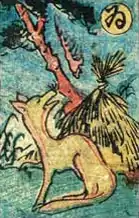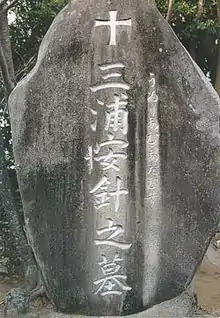Wi (kana)
Wi (hiragana: ゐ, katakana: ヰ) is a nearly obsolete Japanese kana (Japanese phonetic characters, each of which represents one mora). The combination of a W-column kana letter with ゐ゙ in hiragana was introduced to represent [vi] in the 19th century and 20th century. It is presumed that 'ゐ' represented [wi] ⓘ, and that 'ゐ' and 'い' represented distinct pronunciations before merging to [i] sometime between the Kamakura and Taishō periods. Along with the kana for we ('ゑ' in hiragana, 'ヱ' in katakana), this kana was deemed obsolete in Japanese with the orthographic reforms of 1946, to be replaced by 'い/イ' in all contexts. It is now rare in everyday usage; in onomatopoeia and foreign words, the katakana form 'ウィ' (U-[small-i]) is preferred.
| wi | |||
|---|---|---|---|
| |||
| transliteration | wi | ||
| hiragana origin | 爲 | ||
| katakana origin | 井 | ||
| Man'yōgana | 位 為 謂 井 猪 藍 | ||
| spelling kana | ゐどのヰ Wido no "wi" | ||
| unicode | U+3090, U+30F0 | ||
| braille | |||
| kana gojūon | ||||||||||||||||||||||||||||||||||||||||||||||||||||||||||||
|---|---|---|---|---|---|---|---|---|---|---|---|---|---|---|---|---|---|---|---|---|---|---|---|---|---|---|---|---|---|---|---|---|---|---|---|---|---|---|---|---|---|---|---|---|---|---|---|---|---|---|---|---|---|---|---|---|---|---|---|---|
|
||||||||||||||||||||||||||||||||||||||||||||||||||||||||||||
| Kana modifiers and marks | ||||||||||||||||||||||||||||||||||||||||||||||||||||||||||||
| Multi-syllabic kana | ||||||||||||||||||||||||||||||||||||||||||||||||||||||||||||
The kana still sees some modern-day usage, however. The spelling of whisky is usually uisukii ("ウイスキー"), but is sometimes written uwisukii ("ウヰスキー") stylistically, such as Nikka Whisky (ニッカウヰスキー, nikka uwisukii). The name of the comedy duo Yoiko is written yowiko ("よゐこ"), a character in the video game series Touhou Project has the name "てゐ" (Tewi) and the first opening theme to the Future Diary anime series is titled "空想メソロギヰ" (Kuusou Mesorogiwi). The katakana ヰ is sometimes written with a dakuten, 'ヸ', to represent a /vi/ sound in foreign words; however, most IMEs lack a convenient way to do this. It is far more common for /vi/ to be represented by the combination 'ヴィ'.
Hiragana 'ゐ' is still used in one of the Okinawan orthographies, New Okinawan, for the syllable /wi/ and in digraphs for /kwi, ɡwi/. In the Ryukyu University system, the katakana 'ヰ' is used for /i/, while 'い' is /ʔi/. The katakana 'ヰ' is also used in Ainu for /wi/.
History
Nara period (710 – 794 AD)
During the Nara period, ヰ was pronounced as [wi] and イ as [i]. In the Man'yōgana, there were characters to represent ヰ (e.g. 井, 位, 爲, 猪, 謂, 藍) and イ (e.g. 已, 五, 以, 伊, 怡, 射, 移, 異); no characters for one could be used to pronounce the other. The labial glides クヰ [kʷi] and グヰ [gʷi] also existed (though in those days small script kana were not used for glides), and were distinct from キ [ki] and ギ [gi].
Heian Period (794 – 1184 AD)
During the Heian period, ゐ and い were still recognized as separately pronounced characters. In the mid-to-late 11th century, the Iroha song was developed, and い, え, and お (i, e, and o) were differentiated from ゐ, ゑ, and を (wi, we, and wo). In the Gojūon ordering (developed around 1075 by the scholar Hirotomo, based on the Siddhaṃ script), there were no sounds for “yi”, “ye”, “wu”, or “wo”. Although the distinction had been lost between オ (o) and ヲ (wo) as well as 𛀀 (e) and エ (ye), there was still a distinction between ア/ワ (a/wa), イ/ヰ (i/wi), and 𛀀/ヱ (e/we).
In Ki no Tsurayuki's literary work, the Tosa Nikki (originally written in 935, transcribed in 1236), the phrase “海賊報いせむ” (kaizoku mukui semu) is written as “かいぞくむくゐせむ” (kaizoku mukuwi semu), with ゐ where い should be. In this way, examples of confusion between ゐ and い were emerging, little by little; however, during the Heian period these confusions were few and far between.
Since the Nara period, /h/ began to be pronounced as [w] in word-medial position; by the beginning of the 11th century, this phenomenon, called the "Ha-line shift", had become more widespread. In word-medial or word-final position, ひ [ɸi] would be pronounced [wi], therefore becoming the same as ゐ. Because of this, the use of ひ and ゐ also became confused.
At the end of the 12th century, the literary work “Shinkyō Shiki Chū” (which contained katakana, from the last years of the Insei period) attests examples of ゐ and い losing their distinction, such as “率て” (wite) being written “イテ” (ite).
Furthermore, in Heian period literature, special kanji readings such as “クヰヤウ” [kʷʲau] and “ヰヤウ” [wʲau] were used, but were not well established.
Kamakura Period (1185–1333 AD)
By the Kamakura period, the confusion between ゐ and い had become even more widespread, and by the 13th century, ゐ and い were unified. By changing from [wi] to [i], ゐ had merged into い. Also, kanji that were represented by クヰ and グヰ had become pronounced [ki] and [gi] respectively, merging them with キ and ギ.
Due to the Ha-line shift as well as the merging of a number of syllables, soon there were many kana pronounced the same way, and kana orthography was in chaos. Fujiwara no Teika (1162–1241), in the “Unpleasant Characters” (嫌文字事) section of Gekanshū (a poetry volume), established rules for about 60 words containing を/お, え/へ/ゑ, and い/ひ/ゐ, based on a number of writings from the mid-11th to 12th century. However, the books that Teika had referenced already contained a number of confusions, with ひ becoming ゐ, such as 遂 (formerly “つひ” tsuhi) being represented as “つゐ” (tsuwi) and 宵 (formerly “よひ” yohi) being represented as “よゐ” (yowi); い becoming either ひ or ゐ, such as 老い (historically “おい” oi) being represented as “おゐ” (owi) or “おひ” (ohi); and various other spellings differing from their original pronunciation. Teika's syllabary particularly drew from poetry such as waka and renga, but a number of examples of confusion between い, ゐ, and word-medial/final ひ were also frequently pulled from other sources.
Muromachi Period (1333–1573 AD)


In the Nanboku-chō period, the scholar Gyōa published the Kanamojizukai (Kana Character Syllabary, completed in 1363), drastically augmenting the lexicon by over 1000 words. Though the Kanamojizukai was generally as widely accepted as Teika's syllabary, in practice there were a number of kana pronunciations that did not conform to it.
In Christian rōmaji documents from the 16th century (the later part of the Muromachi period), ゐ and い were written with either “i”, “j”, or “y”, but the pronunciation was understood to be [i] in any case.
Stroke order
 Stroke order in writing ゐ |
 Stroke order in writing ヰ |

The Hiragana ゐ is made with one stroke. It resembles the second stroke of the Hiragana ぬ, with an additional short horizontal line at the start.
The Katakana ヰ is made with four strokes:
- A horizontal line.
- A vertical line.
- A horizontal line.
- A vertical line.
Other communicative representations
| Japanese radiotelephony alphabet | Wabun code |
| ゐどのヰ Wido no "Wi" |
ⓘ |
|
|
 | ||
| Japanese Navy Signal Flag | Japanese semaphore | Japanese manual syllabary (fingerspelling) | Braille dots-23 Japanese Braille |
- Full Braille representation
| ゐ / ヰ in Japanese Braille | |||
|---|---|---|---|
| ゐ / ヰ wi | ヸ vi | ゐい / ヰー wī | ヸー vī |
| Preview | ゐ | ヰ | 𛅐 | |||
|---|---|---|---|---|---|---|
| Unicode name | HIRAGANA LETTER WI | KATAKANA LETTER WI | HIRAGANA LETTER SMALL WI | |||
| Encodings | decimal | hex | dec | hex | dec | hex |
| Unicode | 12432 | U+3090 | 12528 | U+30F0 | 110928 | U+1B150 |
| UTF-8 | 227 130 144 | E3 82 90 | 227 131 176 | E3 83 B0 | 240 155 133 144 | F0 9B 85 90 |
| UTF-16 | 12432 | 3090 | 12528 | 30F0 | 55340 56656 | D82C DD50 |
| Numeric character reference | ゐ | ゐ | ヰ | ヰ | 𛅐 | 𛅐 |
| Shift JIS[1] | 130 238 | 82 EE | 131 144 | 83 90 | ||
| EUC-JP[2] | 164 240 | A4 F0 | 165 240 | A5 F0 | ||
| GB 18030[3] | 164 240 | A4 F0 | 165 240 | A5 F0 | 147 54 132 50 | 93 36 84 32 |
| EUC-KR[4] / UHC[5] | 170 240 | AA F0 | 171 240 | AB F0 | ||
| Big5 (non-ETEN kana)[6] | 198 244 | C6 F4 | 199 170 | C7 AA | ||
| Big5 (ETEN / HKSCS)[7] | 199 119 | C7 77 | 199 236 | C7 EC | ||
| Preview | 𛅤 | ヸ | ㋼ | |||
|---|---|---|---|---|---|---|
| Unicode name | KATAKANA LETTER SMALL WI | KATAKANA LETTER VI | CIRCLED KATAKANA WI | |||
| Encodings | decimal | hex | dec | hex | dec | hex |
| Unicode | 110948 | U+1B164 | 12536 | U+30F8 | 13052 | U+32FC |
| UTF-8 | 240 155 133 164 | F0 9B 85 A4 | 227 131 184 | E3 83 B8 | 227 139 188 | E3 8B BC |
| UTF-16 | 55340 56676 | D82C DD64 | 12536 | 30F8 | 13052 | 32FC |
| Numeric character reference | 𛅤 | 𛅤 | ヸ | ヸ | ㋼ | ㋼ |
| Shift JIS (KanjiTalk 7)[8] | 136 107 | 88 6B | ||||
| Shift JIS (JIS X 0213)[9] | 132 147 | 84 93 | ||||
| EUC-JP (JIS X 0213)[10] | 167 243 | A7 F3 | ||||
| GB 18030[3] | 147 54 134 50 | 93 36 86 32 | 129 57 167 54 | 81 39 A7 36 | ||
References
- Unicode Consortium (2015-12-02) [1994-03-08]. "Shift-JIS to Unicode".
- Unicode Consortium; IBM. "EUC-JP-2007". International Components for Unicode.
- Standardization Administration of China (SAC) (2005-11-18). GB 18030-2005: Information Technology—Chinese coded character set.
- Unicode Consortium; IBM. "IBM-970". International Components for Unicode.
- Steele, Shawn (2000). "cp949 to Unicode table". Microsoft / Unicode Consortium.
- Unicode Consortium (2015-12-02) [1994-02-11]. "BIG5 to Unicode table (complete)".
- van Kesteren, Anne. "big5". Encoding Standard. WHATWG.
- Apple Computer (2005-04-05) [1995-04-15]. "Map (external version) from Mac OS Japanese encoding to Unicode 2.1 and later". Unicode Consortium.
- Project X0213 (2009-05-03). "Shift_JIS-2004 (JIS X 0213:2004 Appendix 1) vs Unicode mapping table".
- Project X0213 (2009-05-03). "EUC-JIS-2004 (JIS X 0213:2004 Appendix 3) vs Unicode mapping table".

